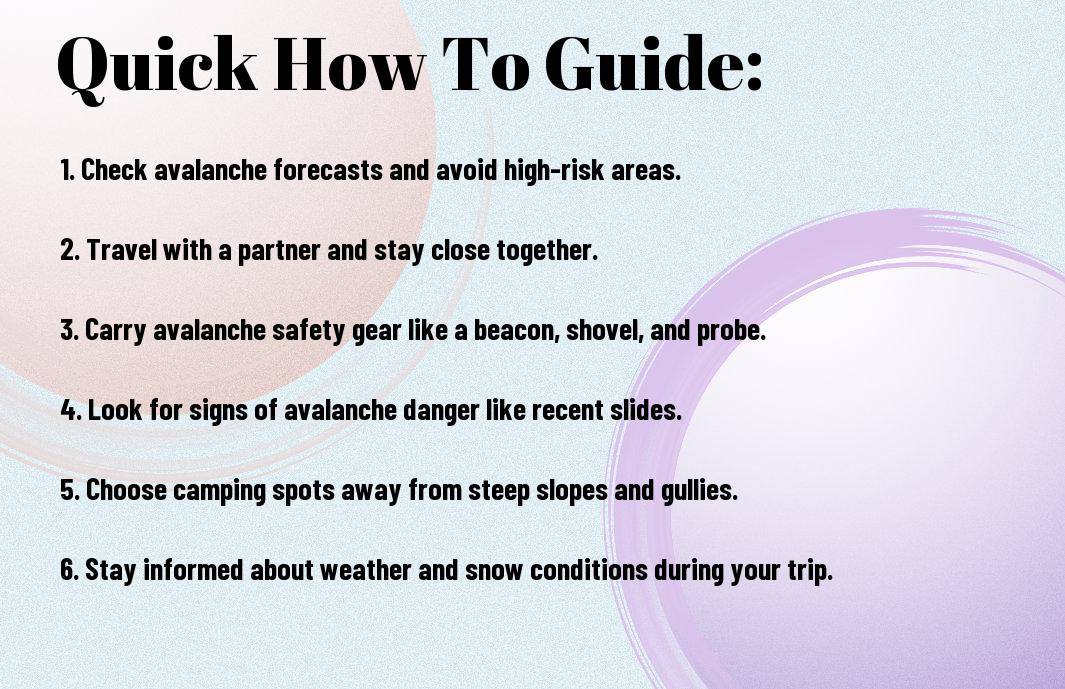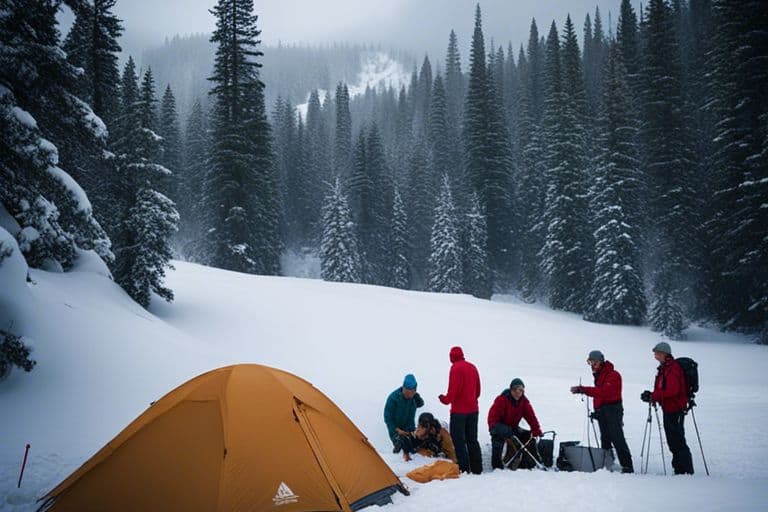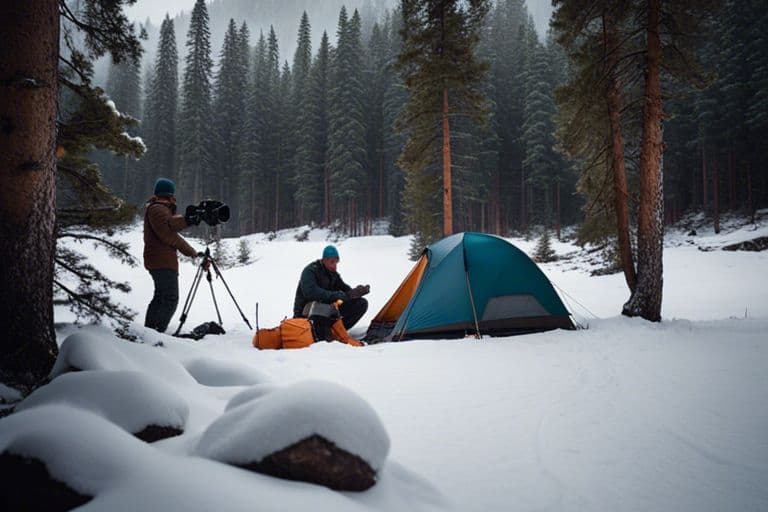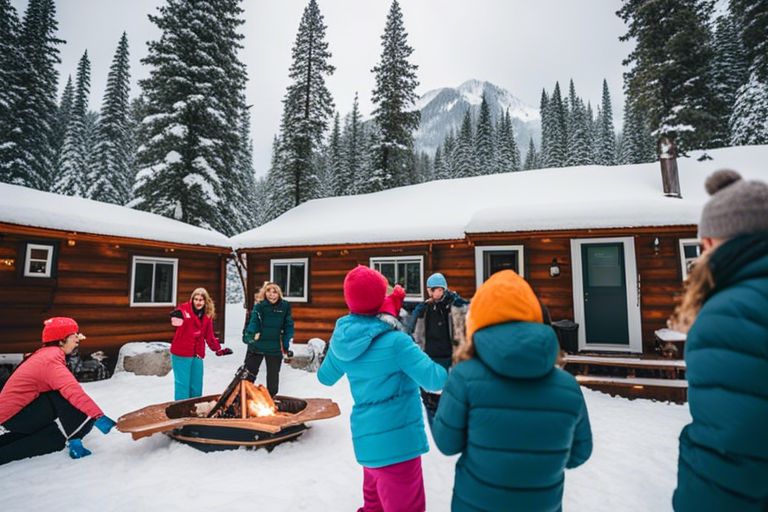Embracing the serene beauty of a winter landscape while camping in heavy snow can be an exhilarating experience. However, when venturing into these environments, it’s crucial that you are aware of the avalanche dangers that can lurk in the backcountry. Navigating through snowy terrain requires a combination of caution, preparedness, and vigilance to ensure your safety. In this guide, you will learn essential tips for avoiding avalanche dangers and safely enjoying winter camping in heavy snow.
Before heading out into the winter wonderland, it’s imperative that you are familiar with the signs of potential avalanches and how to navigate through high-risk areas. Understanding the terrain, weather conditions, and snowpack stability will be crucial in making informed decisions. Additionally, equipping yourself with the proper gear such as avalanche transceivers, shovels, and probes, and knowing how to use them effectively can be lifesaving. Throughout this guide, you will gain the knowledge and tools needed to confidently navigate and avoid avalanche dangers while winter camping.
Key Takeaways:
- Educate Yourself: Understand the basics of avalanche safety, including terrain types, snowpack analysis, and weather conditions that can increase avalanche risk.
- Plan Ahead: Research the area you’ll be camping in and check avalanche forecasts before your trip. Choose camping spots away from potential avalanche paths.
- Carry the Right Gear: Always have essential avalanche safety equipment such as transceivers, shovels, and probes. Practice using them before heading out.
- Stay Informed: Monitor weather conditions and avalanche bulletins while camping. Adjust your plans and routes accordingly to avoid dangerous areas.
- Travel in Groups: Always have at least one partner while navigating in avalanche-prone areas. Practice safe travel techniques and communicate constantly with your group.

Pre-Trip Planning
Some of the most critical aspects of winter camping in heavy snow relate to understanding and avoiding avalanche dangers. Pre-trip planning is key to ensuring a safe and enjoyable backcountry experience.
Researching the Area for Avalanche Risk Factors
Before your winter camping trip, it’s essential to research the area for avalanche risk factors. Look for recent avalanche activity, terrain steepness, and slope aspect. Check for local avalanche forecasts and reports, and pay attention to any terrain traps, such as gullies or cliffs, that can increase the danger of an avalanche. Understand that avalanches can occur on slopes as gentle as 20 degrees in certain conditions.
- Terrain Steepness: Look for slopes between 30-45 degrees, which are the most prone to avalanches.
- Slope Aspect: South-facing slopes are generally more prone to avalanches due to sun exposure and warming temperatures.
- Terrain Traps: Be aware of gullies, cliffs, or other areas where avalanche debris can accumulate, increasing the risk to you.
Though avalanche forecasts and reports are helpful, remember that it’s still essential to use your own judgment and assess the snowpack and conditions first-hand when you arrive at your camping location.
Essentials of Weather and Snowpack Analysis
Understanding weather and snowpack analysis is crucial in assessing avalanche dangers. Pay attention to recent weather patterns, including snowfall, wind, and temperature changes, as these can greatly affect the stability of the snowpack. Fresh snowfall, high winds, and rapid temperature fluctuations can increase the risk of avalanches. You should also perform snowpack tests to evaluate the stability of the snow layers and look for signs of instability, such as recent avalanches, cracking, or collapsing snow.
Gathering Necessary Gear for Avalanche Safety
When planning for a winter camping trip in heavy snow, ensure that you have all the necessary gear for avalanche safety. This includes, but is not limited to, an avalanche transceiver, shovel, and probe. Additionally, consider bringing along an avalanche airbag backpack for added safety. It’s also crucial to have a basic understanding of how to use this gear effectively in the event of an avalanche. Proper gear and knowledge are your best defenses against avalanche dangers.
Selecting a Safe Campsite
Not all campsites are created equal, especially in avalanche-prone areas. When choosing a site for winter camping, it’s crucial to consider the potential avalanche dangers and select a safe location to set up camp. Your campsite should be away from avalanche paths or any terrain that could pose a risk of avalanche danger.
Identifying Potential Avalanche Terrain
Before you even set off on your winter camping trip, it’s important to have a good understanding of potential avalanche terrain. Look for signs of recent avalanches, such as fractured snow or debris, and steer clear of those areas. Pay attention to steep slopes, gullies, and areas with a large amount of snow buildup – these are all indicators of potential avalanche terrain. It’s crucial to identify and avoid these areas when selecting a campsite.
Tips for Avoiding Common Danger Zones
When it comes to avoiding common avalanche danger zones, knowledge is your best defense. Stay away from areas with overhanging cornices, as they can collapse and trigger an avalanche. Additionally, be wary of convex slopes, as they are more prone to avalanches. Stick to low-angle terrain whenever possible, and avoid traveling on or underneath steep slopes. If you encounter a slope that seems suspect, try to find an alternative route or approach it cautiously. When crossing avalanche paths, do so quickly and one at a time, minimizing your exposure to potential danger. Steer clear of terrain traps such as gullies, as they can increase the consequences of an avalanche. Assume that any area with a slope angle greater than 30 degrees has the potential for avalanche activity.
Using Topographical Maps and Tools
When planning your winter camping trip, it’s important to utilize topographical maps and tools to identify potential avalanche terrain. Look for slopes greater than 30 degrees and mark them on your map. Use avalanche forecasts and weather reports to help you identify high-risk areas and plan a safe route to your campsite. Tools such as avalanche transceivers, probes, and shovels are essential for your safety in the event of an avalanche, so make sure you are proficient in using them.

Snowpack Assessment Techniques
Keep in mind that when you’re winter camping in heavy snow, you need to be aware of the potential dangers of avalanches. In order to navigate and avoid these dangers, it’s important to understand how to assess the snowpack around you. There are several techniques you can use to gauge the stability of the snowpack and minimize the risk of avalanches.
How to Conduct a Compression Test
One of the most important snowpack assessment techniques is the compression test. To conduct this test, you’ll need to dig a pit in the snowpack and isolate a column of snow. Then, you’ll apply strong downward force to the top of the column to see how it reacts. The goal of the compression test is to identify weak layers within the snowpack that could potentially cause an avalanche. By conducting this test, you can determine how likely the snowpack is to collapse and trigger an avalanche under the weight of a person or a load.
Understanding Layering and the Signs of Instability
Another crucial aspect of snowpack assessment is understanding the layers within the snowpack and recognizing the signs of instability. You should be able to identify weak layers, such as hoar frost or faceted crystals, which can increase the risk of avalanches. Additionally, you need to be aware of red flags such as recent avalanches, whumpfing sounds, or shooting cracks, all of which indicate that the snowpack is unstable and poses a high risk of avalanche. By understanding the layering and signs of instability, you can make informed decisions about where to camp and travel, minimizing the risk of encountering avalanche dangers.
Avalanche Safety Skills
Now that you have chosen to go winter camping in heavy snow, it is crucial that you are equipped with the necessary avalanche safety skills to stay safe in the backcountry. Being able to recognize avalanche dangers and knowing how to navigate and avoid them is essential for your safety and the safety of your group. Here are the key avalanche safety skills you need to have while winter camping.
How to Use an Avalanche Beacon
When traveling in avalanche terrain, having an avalanche beacon is essential. If someone in your group is caught in an avalanche, a beacon is crucial for locating them quickly. Make sure you know how to use your beacon properly before venturing into avalanche terrain. Practice using it regularly so that you are confident in your ability to use it effectively in the event of an emergency. Remember, it’s not just about having the equipment – knowing how to use it can make all the difference in a time-sensitive situation.
Probing and Shoveling Techniques
Being able to efficiently probe and shovel in the event of an avalanche is crucial for potentially saving someone’s life. If one of your group members is buried in the snow, you need to be able to quickly and accurately locate them and dig them out. Practice using your probe and shovel before your trip so you are proficient in their use. Speed and accuracy are of the essence in an avalanche rescue situation – having strong probing and shoveling techniques can mean the difference between life and death.
Recognizing Natural Warning Signs of Instability
Recognizing natural warning signs of instability in the snowpack is an essential skill for avoiding avalanche dangers. Look for signs such as recent avalanches, cracking or collapsing of the snowpack, and signs of wind loading. Understanding the terrain and being able to identify potential avalanche paths and runout zones can help you make informed decisions about where it is safe to travel. Being able to recognize these warning signs could potentially save your life and the lives of those with you.
Implementing Risk Mitigation Strategies
For any winter camping adventure in heavy snow, it’s essential to implement risk mitigation strategies to keep yourself and your group safe from avalanche dangers. By understanding and applying these strategies, you can reduce the risk of being caught in an avalanche and increase your chances of a successful and safe winter camping experience.
Traveling Safely Through Avalanche Terrain
When traveling through avalanche terrain, it’s crucial to be aware of the potential risks and take proactive measures to mitigate them. Always check the current avalanche forecast for the area you plan to visit and avoid traveling in avalanche-prone areas during high-risk conditions. Familiarize yourself with the signs of unstable snow conditions, such as recent avalanches, cracking or collapsing snow, and rapid changes in weather. If you must travel through avalanche terrain, consider traveling one at a time in exposed areas, carry avalanche safety equipment, and maintain safe travel distances between members of your group.
Establishing Safe Zones and Escape Routes
When setting up camp in heavy snow, the location of your campsite can greatly impact your safety in case of an avalanche. Look for a campsite that is located in a designated safe zone, such as a flat area with no overhead avalanche paths, and away from potential starting zones. In addition to choosing a safe location, it’s important to establish and communicate escape routes from your campsite in case of an avalanche. Make sure everyone in your group knows the quickest and safest way to higher ground or open terrain, and conduct regular drills to ensure everyone is prepared to act quickly in an emergency.
Emergency Preparedness and Response
After learning about how to avoid avalanche dangers while winter camping, it is important to also be prepared for the possibility of an avalanche and know how to respond in case of an emergency. Being equipped with the right knowledge and tools can make a difference in potentially life-threatening situations.
Creating an Emergency Action Plan
When you are winter camping in heavy snow, it is crucial to have an emergency action plan in place. This plan should include communication protocols, emergency contacts, and a clear outline of what to do in the event of an avalanche. You should also designate a meeting place in case your group gets separated during an emergency. Make sure that everyone in your group is familiar with the plan and knows what to do.
Immediate Steps if Caught in an Avalanche
If you find yourself caught in an avalanche, the first thing you should do is try to get out of the way of the moving snow. You should also try to grab onto something solid, such as a tree or rock, to prevent being carried further by the avalanche. If that’s not possible, try to “swim” to keep yourself near the surface of the snow. Remember, avalanches are fast, so you need to act quickly. Do not panic and try to stay as calm as possible.
Administering First Aid and Seeking Help
If you or someone in your group is injured during an avalanche, it is important to administer first aid as quickly as possible. Assess the situation and attend to any immediate medical needs. Once the immediate medical needs are addressed, seek help immediately. Use any means of communication available, such as a satellite phone or emergency beacon, to call for rescue. Time is of the essence in these situations, so prompt action is essential.
Conclusion
Ultimately, staying safe while winter camping in heavy snow requires careful navigation and awareness of avalanche dangers. By following the guidelines outlined in the Outdoor Action Guide to Winter Camping, you can minimize the risks of encountering an avalanche. Always be prepared with the right gear, such as an avalanche beacon, probe, and shovel, and constantly assess the terrain for potential hazards. Your ability to navigate through avalanche terrain and make informed decisions will significantly reduce the likelihood of encountering dangerous situations.
Remember that even the most experienced winter campers can be at risk of avalanches, so it’s crucial to continuously educate yourself on avalanche safety and risk assessment. Always keep up-to-date with current weather conditions and avalanche forecasts to make informed decisions about your camping location and route. By staying informed and prepared, you can enjoy the beauty of winter camping in heavy snow while minimizing the potential dangers of avalanches.
For more detailed information, be sure to consult the Outdoor Action Guide to Winter Camping.
Winter Camping and Avalanche Safety FAQ
Q: What are the key steps to navigating and avoiding avalanche dangers while winter camping in heavy snow?
A: When winter camping in heavy snow, it is essential to first educate yourself about avalanche terrain and conditions. This includes understanding the local avalanche bulletin, recognizing warning signs such as recent avalanches, and being aware of terrain traps. Always carry and know how to use avalanche safety equipment, including an avalanche transceiver, shovel, and probe. It is also important to practice safe route-finding, sticking to low-angle terrain whenever possible and avoiding slopes steeper than 30 degrees.
Q: What should I do if I encounter avalanche conditions while winter camping?
A: If you encounter avalanche conditions while winter camping, the first step is to immediately communicate with your group and carefully re-evaluate your route. Consider turning around or finding an alternative way to your destination if the terrain poses a significant risk. It is crucial to keep an eye out for signs of recent avalanche activity, unstable snowpack, or collapsing and cracking snow. If you suspect avalanche danger, exercise caution and consider camping in a safer location. Always remember that no trip is worth risking your safety.
Q: How can I be prepared and equipped to handle avalanche dangers while winter camping?
A: Being prepared and properly equipped is crucial for handling avalanche dangers while winter camping. Make sure to check the local avalanche forecast and gather up-to-date information before setting out on your trip. It is essential to have the necessary avalanche safety gear, including a transceiver, shovel, and probe, and to know how to use them effectively. Additionally, consider taking a certified avalanche safety course to learn essential skills like snowpack evaluation, safe travel techniques, and rescue procedures. Always carry a communication device such as a satellite phone or two-way radio to call for help in an emergency, and make sure to inform others of your planned route and expected return time.



0 Comments